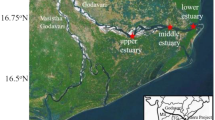Abstract
Based on the results of water sample measurements of nutrient concentrations at the Datong Station of the Changjiang River from 1998 to 1999, combined with historical data of water quality, seasonal variations of nutrient concentrations and nutrient transports are discussed. The following results have been obtained: (1) the fluxes of the nitrate nitrogen, ammonium nitrogen and nitrite nitrogen increased by time-series from 1962 to 1990, even if runoff volume had a little variation; (2) the concentrations and fluxes of the dissolved inorganic nitrogen (DIN) and dissolved inorganic phosphorus (DIP) increased notably with time, but those of the dissolved silicon (DSI) decreased pronouncedly; and (3) the concentrations and fluxes changed synchronously with time between the Datong Station and the Changjiang Estuary.
Similar content being viewed by others
References
Chameides W L, Perdue E M, 1997. Biogeochemical Cycles: A Computer-interactive Study of Earth System Science and Global Change. New York, Oxford: Oxford University Press, 103–105.
Chen J S, Guan W R, Xia X Het al., 1998. A probe into several problems of water-quality trends in the mainstream of Yangtze River from 1960’s to 1980’s.Environmental Chemistry, 17(1): 8–13. (in Chinese)
Committee of Analytical Method of Water and Wastewater, 1989. Analytical Method of Water and Wastewater. Beijing: China Environmental Science Press, 252–286. (in Chinese)
Correll D I, Jorden T E, Weller D E, 1992. Nutrient flux in a landscape: effects of coastal land use and terrestrial community mosaic on nutrient transport to coastal waters.Estuaries, 15: 431–442.
Duan Shuiwang, Zhang Shen, Huang Hongyu, 2000. Transport of dissolved inorganic nitrogen from the major rivers to estuaries in China.Nutrient Cycling in Agroecosystems, 57: 13–22.
Galloway J N, Schlesinger W H, Hiram-Levy Het al., 1995. Nitrogen fixation: Anthropogenic enhancement-environmental response.Global Biogeochemical Cycles, 9(12): 235–252.
Huang S G, Yang J D, Ji W Det al., 1986. Temporal and spatial change in concentrations of active Si, N and P in waters of Changjiang River mouth and their relationships.Taiwan Strait, 5(2): 114–122. (in Chinese)
Jin C L, 1996. Brief assessment of the water resources quality of China.Hydrology, 5: 1–7. (in Chinese)
Kim Ki-Hyun, Heo Woo-myung, Kim Bomchul, 1998. Spatial and temporal variabilities in nitrogen and phosphorous in the Nakdong River system, Korea.Water, Air and Soil Pollution, 196: 36–60.
Li Maotian, Cheng Heqin, 2001. Changes of dissolved silicate flux from the Changjiang River into sea and its influence since late 50 years.China Environmental Science, 21: 193–197.
Lin Yan, Tang Renyou, Li Yan, 1997. Effect of biogeochemical variations of C, N, and P on flocculation and settling of suspended particles in the Changjiang Estuary. In: Zhang J (ed.), Biogeochemical Study of the China’s Main Estuary (Chemical matters transport and environment), 133–145.
Meybeck M, 1982. Carbon, nitrogen and phosphorus transport by world rivers.Amer. J. Sci., 282: 401–450.
Meybeck M, 1994. Origin and variable composition of present day riverborne material. In: Material Transport on the Surface of the Earth. Washington D.C.: National Academy Press.
McKee L J, Eyre B D, 2000. Nitrogen and phosphorus budgets for the sub-tropical Richmond River catchment, Australia.Biogeochemistry, 50: 207–239.
Roberts G, 1987. The effects of agricultural practices on the nitrate concentration in the surface of water domestic supply sources of West Europe. Hydrology in Perspective. IAHS Publ., 164, 365–380.
Rotmans J, Den Elzen M, 1999. Global biogeochemical cycles. In: Martens P, Rotmans J (eds.), Climate Change: An Integrated Perspective. Dordrecht: Kluwer Academic Publ., 105–142.
Shen Huanting, 2001. Material Flux of the Changjiang Estuary. Beijing: Ocean Press, 176. (in Chinese)
Shen Zhiliang, 1991. The affected study the distribution change of nutrients in the sea of the Changjiang Estuary by "Three Gorges Project".Oceanologia et Limnologia Sinica, 22: 540–546.
Shen Zhiliang, 1997. Preliminary study on the Changjiang River mainstream nutrients fluxes.Oceanologia et Limnologia Sinica, 28: 522–528.
Su Jilan, 2001. Harmful algal bloom and its research in China.Bulletin of the Chinese Academy of Sciences, 16(5): 389–342.
Van Breeman N, 2001. Natural organic tendency.Nature, 415: 381–382.
Wang Mingyuan, Zhao Guijiu, Zhang Shen, 1989. Studies on the amount of C, N, P, and S transport from Yangtze. In: Studies on Background Values of Water Environment for chemical Elements. Beijing: Surveying and Mapping Publishing House. (in Chinese)
Yan W, Zhang S, Wang J, 2001. Nitrogen biogeochemical cycling in the Changjiang drainage basin and its effect on Changjiang River dissolved inorganic nitrogen: temporal trend for the period 1968–1997.Acta Geographica Sinica, 56: 506–514. (in Chinese)
Zhang J, 1994. Eco-social impact and chemical regimes of large Chinese rivers.Wat. Res., 28: 609–617.
Zhang Jet al., 1995. Chemical trend of national rivers in China: Huanghe and Yangtze.AMBIO, 24: 274–278.
Zhang J, Zhang Z F, Liu S Met al., 1999. Human impacts on the large world rivers: would the Changjiang (Yangtze River) be an illustration?Global Biogeochem. Cycles, 13: 1099–1105.
Author information
Authors and Affiliations
Additional information
Foundation item: National Natural Science Foundation of China, No.39790110
Author: Zhang Shen (1933–2002), Academican of CAS, specialized in biogeochemistry and environmental science
Rights and permissions
About this article
Cite this article
Zhang, S., Ji, H., Yan, W. et al. Composition and flux of nutrients transport to the Changjiang Estuary. J. Geogr. Sci. 13, 3–12 (2003). https://doi.org/10.1007/BF02873141
Received:
Accepted:
Issue Date:
DOI: https://doi.org/10.1007/BF02873141




